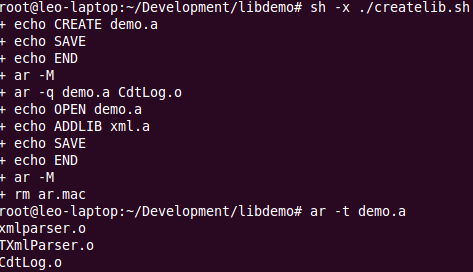Linux动态库与静态库制作及使用详解
作者:网络转载 发布时间:[ 2016/7/20 10:20:50 ] 推荐标签:操作系统 Linux
Linux 下静态库(archive)的制作方式:
涉及命令:ar
ar 简介:处理创建、修改、提取静态库的操作
涉及选项:
t – 显示静态库的内容
r[ab][f][u] – 更新或增加新文件到静态库中
[s] – 创建文档索引
ar -M [<mri-script] – 使用 ar 脚本处理
其他详细说明请参阅 man 说明。
示例情景:
假设现有如 图 7所示两个库文件

示例静态库文件
从 图 7中可以得知,CdtLog.a 只包含 CdtLog.o 一个对象文件 , 而 xml.a 包含 TXmlParser.o 和 xmlparser.o 两个对象文件
现将 CdtLog.o 提取出来,然后通过 图 8方式创建一个新的静态库 demo.a,可以看出,demo.a 包含的是 CdtLog.o 以及 xml.a,
而不是我们所预期的 CdtLog.o,TXmlParser.o 和 xmlparser.o。这正是区别于 Windows 下静态库的制作。

示例静态库制作方式 1
这样的 demo.a 当被链接入某个工程时,所有在 TXmlParser.o 和 xmlparser.o 定义的符号都不会被发现,从而会导致链接错误,
提示无法找到对应的符号。显然,通过图 8 方式创建 Linux 静态库是不正确的。
正确的方式有两种:
将所有静态库中包含的对象文件提取出来然后重新打包成新的静态库文件。
用一种更加灵活的方式创建新的静态库文件:ar 脚本。
显然,方式 1 是比较麻烦的,因为涉及到太多的文件处理,可能还要通过不断创建临时目录用于保存中间文件。
推荐使用如 清单 2 createlib.sh所示的 ar 脚本方式进行创建:
清单 2 createlib.sh
rm demo.a
rm ar.mac
echo CREATE demo.a > ar.mac
echo SAVE >> ar.mac
echo END >> ar.mac
ar -M < ar.mac
ar -q demo.a CdtLog.o
echo OPEN demo.a > ar.mac
echo ADDLIB xml.a >> ar.mac
echo SAVE >> ar.mac
echo END >> ar.mac
ar -M < ar.mac
rm ar.mac
如果想在 Linux makefile 中使用 ar 脚本方式进行静态库的创建,可以编写如 清单 3 BUILD_LIBRARY所示的代码:
清单 3 BUILD_LIBRARY
define BUILD_LIBRARY
$(if $(wildcard $@),@$(RM) $@)
$(if $(wildcard ar.mac),@$(RM) ar.mac)
$(if $(filter %.a, $^),
@ echo CREATE $@ > ar.mac
@ echo SAVE >> ar.mac
@ echo echo END >> ar.mac
@$(AR) -M < ar.mac
)
$(if $(filter %.o,$^),@$(AR) -q $@ $(filter %.o, $^))
$(if $(filter %.a, $^),
@ echo OPEN $@ > ar.mac
$(foreach LIB, $(filter %.a, $^),
@ echo ADDLIB $(LIB) >> ar.mac
)
@ echo SAVE >> ar.mac
@ echo END >> ar.mac
@$(AR) -M < ar.mac
@$(RM) ar.mac
)
endef
$(TargetDir)/$(TargetFileName):$(OBJS)
$(BUILD_LIBRARY)
通过 图 9,我们可以看到,用这种方式产生的 demo.a 才是我们想要的结果。

巧妙创建的静态库文件结果
Linux 静态库链接顺序问题及解决方法:
正如 GCC 手册中提到的那样:
It makes a difference where in the command you write this option; the linker
searches and processes libraries and object files in the order they are specified.
Thus, ‘ foo.o -lz bar.o ’ searches library ‘ z ’ after file ‘ foo.o ’ but before
‘ bar.o ’ . If ‘ bar.o ’ refers to functions in ‘ z ’ , those functions may not be loaded.
为了解决这种库链接顺序问题,我们需要增加一些链接选项 :
$(CXX) $(LINKFLAGS) $(OBJS) -Xlinker “-(” $(LIBS) -Xlinker “-)” -o $@
通过将所有需要被链接的静态库放入 -Xlinker “-(” 与 -Xlinker “-)” 之间,可以是 g++ 链接过程中, 自动循环链接所有静态库,从而解决了原本的链接顺序问题。
涉及链接选项:-Xlinker
-Xlinker option
Pass option as an option to the linker. You can use this to supply system-specific
linker options which GCC does not know how to recognize.
小结
本文介绍了 Linux 下三种标准库链接的方式及各自利弊,同时还介绍了 Linux 下静态库的制作及使用方法,相信能够给 大多数需要部署 Linux 应用程序和编写 Linux Makefile 的工程师提供有用的帮助。
相关推荐

更新发布
功能测试和接口测试的区别
2023/3/23 14:23:39如何写好测试用例文档
2023/3/22 16:17:39常用的选择回归测试的方式有哪些?
2022/6/14 16:14:27测试流程中需要重点把关几个过程?
2021/10/18 15:37:44性能测试的七种方法
2021/9/17 15:19:29全链路压测优化思路
2021/9/14 15:42:25性能测试流程浅谈
2021/5/28 17:25:47常见的APP性能测试指标
2021/5/8 17:01:11













 sales@spasvo.com
sales@spasvo.com